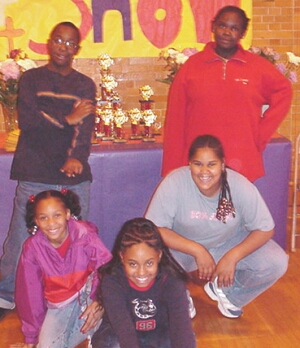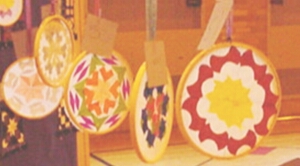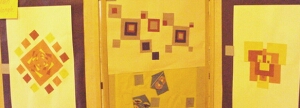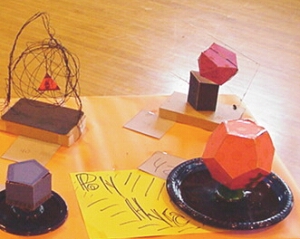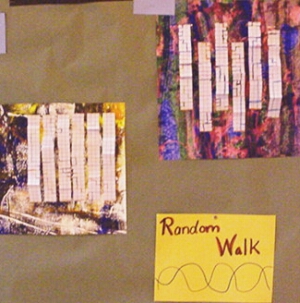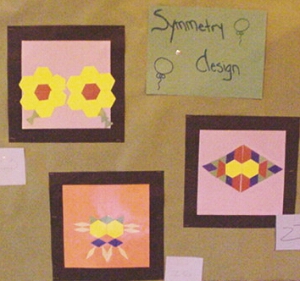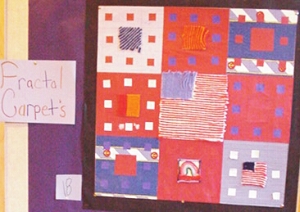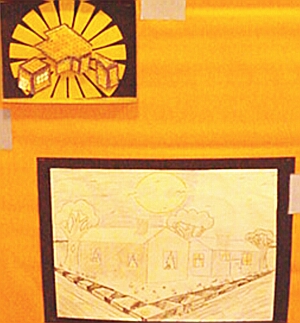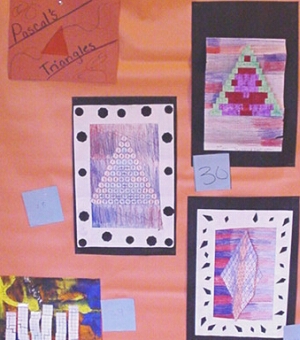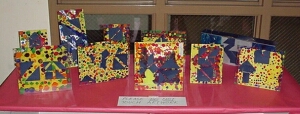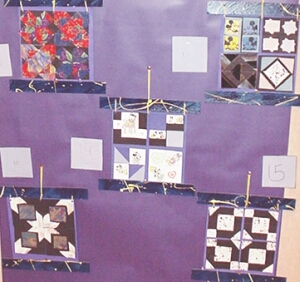| Introduction | Main Idea | Lessons | Picture gallery | Links/Downloads |
| John's Homepage |
The Math in Art festival is the brainchild of Susan Walborn, math specialist at Aberdeen Math/Tech Academy, an open admission city wide school in the Grand Rapids Public School system. In addition to being an excellent math teacher, Susan is an artist representative and co-owner of a gallery/stationary store in Grand Rapids (Yours Truly on Cherry St.) She was looking for a schoolwide festival to end the year on a positive note, after long struggles with possible school closings, etc. My involvement at Aberdeen has been through preservice placement for geometry and measurement lessons and for tutoring. When she mentioned it to me, I was immediately enthusiastic as it combines two of my great loves.
The idea of the festival quickly took off and was adopted by the school, students, parents, teachers and administration. Susan brought in an art intern from the Maryland Institute College of Art, a preservice Teacher by the name of Joanne Pereira, who was invaluable. Principal Barb Todd also gave impressive support and encouragement. Dana Bradt was an amazing organizer for the actual festival day.
The festival was held twice, in the 2nd year with funding support from the Grand Rapids Council of the Arts, an artist in residence, and actual compensation for the student intern. The 2nd year Mike Klann was the artistic director (and a 2nd grade teacher), Amy Archangeli was the art intern, Dana Bradt was the administrator (and PTA president) Susan was the mathematics director, and we worked in cooperation with the Technology specialist, Chris Strevel. (I was either a co-mathematics director or a consultant... I can't remember the title!)
The idea is to have a combined math/art lesson that has as a product a piece of art. Classes then voted anonymously on their pieces, choosing the top three to go to a school wide art show to be held simultaneously with a festival day. On the festival day, attendees voted on their favorite works from the entire show, and then the top honorees were given awards and trophies. Also at the festival were over 20 booths where students and family members could make an art/math project on the spot, such as tessellations, mosaics, kites, etc. The 2002 festival was very successful, with over 300 students and family members returning to the school in the evening. The Picture Gallery has images from last year's festival.
The lessons had mathematical topics ranging from probability to symmetry to similarity to fractal geometry, and artistic topics such as graphic design, the color wheel, foreground and background, and perspective. The math portion was usually the first half of the lesson and the second half was when the art teacher (most often Joanne) taught a lesson about the art principle at hand and how it applied to their project.
One of the most exciting aspects of the festival was the depth and intensity of student excitement, involvement and participation. The fact that the whole school was participating really generated a feeling of unity. Another exciting aspect was the success and engagement of students who were not known for previous success in mathematics. The anonymous nature of the judging at the class and festival level really empowered the winners with a genuine sense of accomplishment.
| Introduction | Main Idea | Lessons | Picture gallery | Links/Downloads |
| Project - Grade | Math | Art |
| Masks - Kindergarten Students made masks out of shapes chosen and painted by the students. They also chose the shapes and colored them for the facial features. Emotion: | Shape recognition: Students explored and tested knowing the math names for shapes and when different looking shapes have the same math name. They colored shapes with the same math name the same color to demonstrate. | The students learned how facial features show emotion and how to create those emotions in their own art. |
|
Friezes - 1st
Students made friezes from brightly colored paper and foam stickers. |
Patterns and rotations: Students made patterns of two or more colors and continued the pattern around the entire edge. The middle of the frieze should contain a motion pattern made by two choices of stickers. | Border and decoration: Students created their own border decoration that could be carried out for any length of space. |
|
Kaleidoscopes - 2nd
Students investigated the types of patterns found inside real kaleidoscopes, and used hinged mirrors and MIRAs to produce reflectional patterns of their own. |
Reflections and line symmetry: Students disassembled a real kaleidoscope, and used reflections to create their own symmetric patterns. | Symmetry and Design: Students learned how symmetry and pattern make things more visually appealing, and how to design their own compositions with symmetry. |
|
Polyhedra Sculpture - 3rd
Sculptures were designed by students using plastic pieces and then creating a plan that folded into the sculptures, which were then decorated and mounted. |
Polyhedra: Students determined the rules for polygons, and then extended the rules to three dimensions. Sculptures should be simple, closed and have only polygons for faces. | Graphic Design: students investigated and practiced how repeated simple geometric elements are used to create decoration. |
|
Calder Mobiles - 3rd
Students designed pieces, chose colors, placed and balanced the pieces. |
Constant Area: Students explored how different shapes could have the same area, and made 5 different pieces with area of 10 square units. Mean (average): Students explored the relationsip between the mean and balance and used this to find the hanging point for their mobiles. | Alexander Calder: The students learned about the work of Calder and the process he used in creating his mobiles, stressing balance and composition. |
|
Jordan Curves/Pollack - 4th
Students created a design with a single line with no beginning or end and no self-intersections and then created a contrast between the two regions. |
Jordan Curve Theorem: Students learned how to look at the number of regions in a drawing, and then how to create pictures that only had two regions, like a circle creates an inside and an outside. | Jackson Pollack: Students learned about Pollack and how he created his abstract paintings to have lots of energy. Positive/Negative Space: Students learned how contrast is used to make positive and negative space in art. |
|
Warhol Permutations - 4th
Students used digital photography and computer software to create several color variations on a single photograph. |
Permutations: Students learned about permutations, the math of counting how many ways to arrange items when order matters and no repeats are allowed. | Andy Warhol: Students learned about pop art and Warhol?s process in creating his large silkscreen pieces using repeated imagery. See the awesome silk screen demo at the Warhol Museum |
|
Mondrian Squares - 5th:
Students used squares of bright color in certain proportions to create their own geometric abstract compositions. |
Spirals, Fibonacci and the Golden Ratio: Students used a rectangular spiral to find connections to similarity, the Fibonacci Sequence (1, 1, 2, 3, 5, ?) and the Golden Ratio, an abstract mathematical number important to ancient civilizations. | Piet Mondrian and the Jazz Age: Students experienced swing music, and found the connection to Mondrian?s work, especially the piece Broadway Boogie Woogie. They made their pieces thinking about proportion, rhythm and movement. |
|
Fractal Carpets - 5th:
Students used wallpaper and textiles and yarn to create pieces demonstrating self-similarity. |
Fractal Geometry: Students learned how fractals are geometric structures that are similar to themselves, found the connection with exponential patterns and explored the famous example of Sierpinski?s Carpet. | Contrast and theme: Students learned about how to create artistic contrast and to create a theme to be carried out on a piece of art. |
| Grade | Math topic | Art product (topic) |
| Kindergarten | Motions | Friezes |
| First | Probability | Abstract line drawing |
| Second | Reflections | Kaleidoscopes (color connotation) |
| Third | Polyhedra | Sculpture (graphic design) |
| Third | Isometric drawing | Isometric Building Pictures |
| Fourth | Symmetry | Quilting Patterns |
| Fifth | Golden Ratio, Fibonacci Numbers | Geometric abstract collage (Mondrian) |
| Fifth | Fractals, Pascal's Triangle, Patterns | Fractal triangle patterns |
| Sixth | Fractal patterns | Fractal carpet (texture) |
| Introduction | Main Idea | Lessons | Picture gallery | Links/Downloads |
|
|
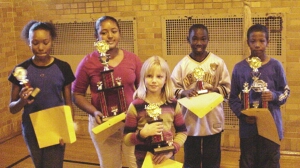
|
More coming soon.
Art Education:
Related
Downloads:
Sketchpad files available to those interested -- just email me.
| Introduction | Main Idea | Lessons | Picture gallery | Links/Downloads |
